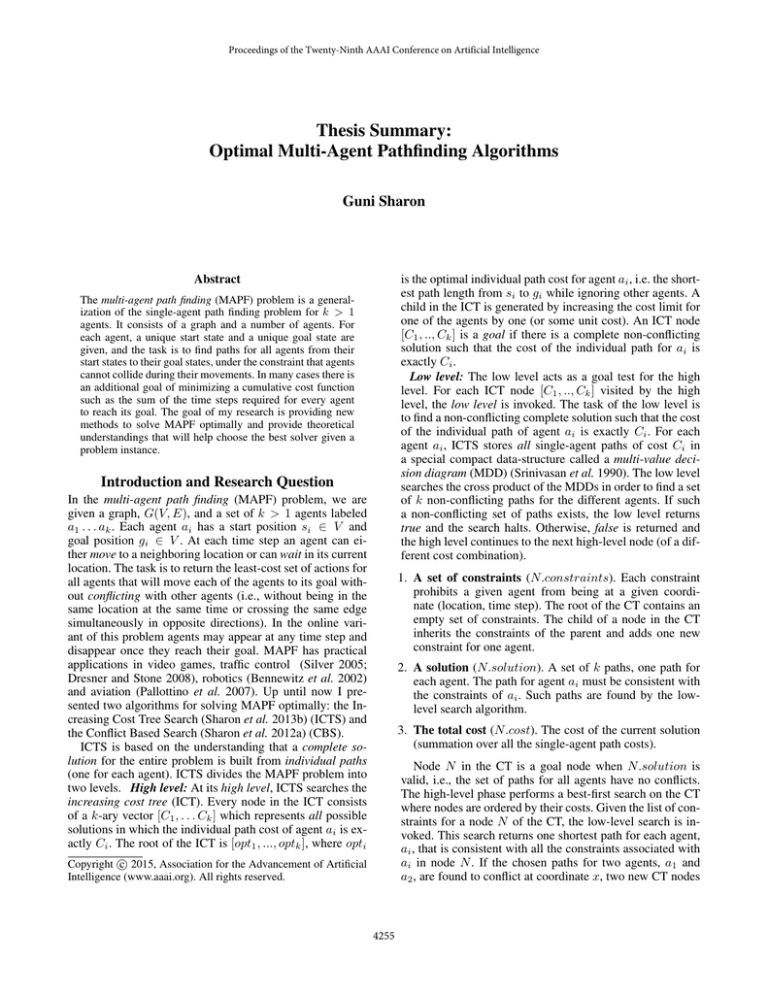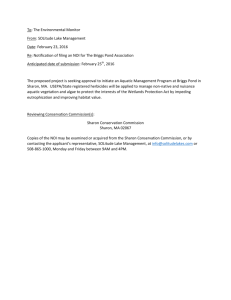
Proceedings of the Twenty-Ninth AAAI Conference on Artificial Intelligence
Thesis Summary:
Optimal Multi-Agent Pathfinding Algorithms
Guni Sharon
is the optimal individual path cost for agent ai , i.e. the shortest path length from si to gi while ignoring other agents. A
child in the ICT is generated by increasing the cost limit for
one of the agents by one (or some unit cost). An ICT node
[C1 , .., Ck ] is a goal if there is a complete non-conflicting
solution such that the cost of the individual path for ai is
exactly Ci .
Low level: The low level acts as a goal test for the high
level. For each ICT node [C1 , .., Ck ] visited by the high
level, the low level is invoked. The task of the low level is
to find a non-conflicting complete solution such that the cost
of the individual path of agent ai is exactly Ci . For each
agent ai , ICTS stores all single-agent paths of cost Ci in
a special compact data-structure called a multi-value decision diagram (MDD) (Srinivasan et al. 1990). The low level
searches the cross product of the MDDs in order to find a set
of k non-conflicting paths for the different agents. If such
a non-conflicting set of paths exists, the low level returns
true and the search halts. Otherwise, false is returned and
the high level continues to the next high-level node (of a different cost combination).
Abstract
The multi-agent path finding (MAPF) problem is a generalization of the single-agent path finding problem for k > 1
agents. It consists of a graph and a number of agents. For
each agent, a unique start state and a unique goal state are
given, and the task is to find paths for all agents from their
start states to their goal states, under the constraint that agents
cannot collide during their movements. In many cases there is
an additional goal of minimizing a cumulative cost function
such as the sum of the time steps required for every agent
to reach its goal. The goal of my research is providing new
methods to solve MAPF optimally and provide theoretical
understandings that will help choose the best solver given a
problem instance.
Introduction and Research Question
In the multi-agent path finding (MAPF) problem, we are
given a graph, G(V, E), and a set of k > 1 agents labeled
a1 . . . ak . Each agent ai has a start position si ∈ V and
goal position gi ∈ V . At each time step an agent can either move to a neighboring location or can wait in its current
location. The task is to return the least-cost set of actions for
all agents that will move each of the agents to its goal without conflicting with other agents (i.e., without being in the
same location at the same time or crossing the same edge
simultaneously in opposite directions). In the online variant of this problem agents may appear at any time step and
disappear once they reach their goal. MAPF has practical
applications in video games, traffic control (Silver 2005;
Dresner and Stone 2008), robotics (Bennewitz et al. 2002)
and aviation (Pallottino et al. 2007). Up until now I presented two algorithms for solving MAPF optimally: the Increasing Cost Tree Search (Sharon et al. 2013b) (ICTS) and
the Conflict Based Search (Sharon et al. 2012a) (CBS).
ICTS is based on the understanding that a complete solution for the entire problem is built from individual paths
(one for each agent). ICTS divides the MAPF problem into
two levels. High level: At its high level, ICTS searches the
increasing cost tree (ICT). Every node in the ICT consists
of a k-ary vector [C1 , . . . Ck ] which represents all possible
solutions in which the individual path cost of agent ai is exactly Ci . The root of the ICT is [opt1 , ..., optk ], where opti
1. A set of constraints (N.constraints). Each constraint
prohibits a given agent from being at a given coordinate (location, time step). The root of the CT contains an
empty set of constraints. The child of a node in the CT
inherits the constraints of the parent and adds one new
constraint for one agent.
2. A solution (N.solution). A set of k paths, one path for
each agent. The path for agent ai must be consistent with
the constraints of ai . Such paths are found by the lowlevel search algorithm.
3. The total cost (N.cost). The cost of the current solution
(summation over all the single-agent path costs).
Node N in the CT is a goal node when N.solution is
valid, i.e., the set of paths for all agents have no conflicts.
The high-level phase performs a best-first search on the CT
where nodes are ordered by their costs. Given the list of constraints for a node N of the CT, the low-level search is invoked. This search returns one shortest path for each agent,
ai , that is consistent with all the constraints associated with
ai in node N . If the chosen paths for two agents, a1 and
a2 , are found to conflict at coordinate x, two new CT nodes
c 2015, Association for the Advancement of Artificial
Copyright Intelligence (www.aaai.org). All rights reserved.
4255
(N1 , N2 ) are generated. At N1 , a1 is constrained from coordinate x and at N2 , a2 is constrained from x.
Many open question and research directions still exist regarding ICTS and CBS, namely:
techniques for solving MAPF that will include new theoretical understandings for characterizing the advantages and
drawbacks of each approach. Simultaneously, I intend to implement and experiment with a sub-optimal variant of the
ICTS algorithm as well as adapting CBS to the online MAPF
variant.
1. Given a problem instance, which algorithm should be
used? - A theoretical understandings on how each of the
algorithms perform in different settings, followed by an
empirical comparison between these algorithms and other
optimal MAPF algorithms.
References
Max Barer, Guni Sharon, Roni Stern, and Ariel Felner. Suboptimal variants of the conflict-based search algorithm for
the multi-agent pathfinding problem. In ECAI 2014 - 21st
European Conference on Artificial Intelligence, 18-22 August 2014, Prague, Czech Republic - Including Prestigious
Applications of Intelligent Systems (PAIS 2014), pages 961–
962, 2014.
Maren Bennewitz, Wolfram Burgard, and Sebastian Thrun.
Finding and optimizing solvable priority schemes for decoupled path planning techniques for teams of mobile robots.
Robotics and autonomous systems, 41(2):89–99, 2002.
Kurt M. Dresner and Peter Stone. A multiagent approach to
autonomous intersection management. Journal of Artificial
Intelligence Research, 31:591–656, 2008.
Lucia Pallottino, Vincenzo Giovanni Scordio, Antonio Bicchi, and Emilio Frazzoli. Decentralized cooperative policy
for conflict resolution in multivehicle systems. Robotics,
23(6):1170–1183, 2007.
Guni Sharon, Roni Stern, Meir Goldenberg, and Ariel Felner. The increasing cost tree search for optimal multi-agent
pathfinding. In IJCAI, pages 662–667, 2011.
Guni Sharon, Roni Stern, Meir Goldenberg, and Ariel Felner. Pruning techniques for the increasing cost tree search
for optimal multi-agent pathfinding. In Symposium on Combinatorial Search (SOCS), 2011.
Guni Sharon, Roni Stern, Ariel Felner, and Nathan R. Sturtevant. Conflict-based search for optimal multi-agent path
finding. In AAAI, 2012.
Guni Sharon, Roni Stern, Ariel Felner, and Nathan R. Sturtevant. Meta-agent conflict-based search for optimal multiagent path finding. In Symposium on Combinatorial Search
(SOCS), 2012.
Guni Sharon, Ariel Felner, Roni Stern, and Nathan R. Sturtevant. Partial domain search tree for constraint-satisfaction
problems. In Late-Breaking Developments in the Field of
Artificial Intelligence, Bellevue, Washington, USA, July 1418, 2013, 2013.
Guni Sharon, Roni Stern, Meir Goldenberg, and Ariel Felner. The increasing cost tree search for optimal multi-agent
pathfinding. Artificial Intelligence, 195:470–495, 2013.
David Silver. Cooperative pathfinding. In Artificial Intelligence and Interactive Digital Entertainment (AIIDE), pages
117–122, 2005.
Arvind Srinivasan, Timothy Ham, Sharad Malik, and
Robert K. Brayton. Algorithms for discrete function manipulation. In International Conference on Computer Aided
Design (ICCAD), pages 92–95, 1990.
2. How to adapt these algorithms to be suboptimal?
3. How to adapt these algorithms to solve online MAPF?
4. How to generalize these algorithms to other problems?
Timeline
Since 2011 (as a MSc. student) I have been researching the
MAPF problem. I intend to continue this line of work and
answer the questions presented above.
Progress so Far
During 2011 I have presented the Increasing Cost Tree
Search (ICTS) (Sharon et al. 2011a). Later that year I presented special pruning techniques that dramatically reduce
the size of the search space used by ICTS (Sharon et al.
2011b). A journal paper that summarize the research on
ICTS was published in 2013 (Sharon et al. 2013b).
During 2012 I presented the Conflict Based Search (CBS)
(Sharon et al. 2012a). CBS has a major drawback when solving MAPF instances that is dense with agents that conflict
frequently. In order to mitigate the drawback of CBS I presented, later that year, a variant of CBS named Meta-Agent
Conflict Based Search (MA-CBS) (Sharon et al. 2012b), for
which I won the SOCS best paper award. Instead of planning
a path for a single agent at a time, MA-CBS allows merging
agents and solving them as a composite agent.
During 2013 I presented a generalization of CBS for solving CSPs (Sharon et al. 2013a). The main idea here is to
view each variable and a value it may take as an agent and a
path it may choose, than solve this problem using CBS. Preliminary results suggest this to be a very promising direction
for future research. Besides being applicable to CSPs, CBS
could be used to solve many other problems. Characterizing
the set of problems that could be solved using CBS is one
direction I aim to pursue.
During 2014 I was part of team researching suboptimal variants for the CBS algorithms (Barer et al. 2014).
The main concept here was to use a greedy search on the
CT while exploiting different heuristic evaluations. Using
greedy search on the ICT for a suboptimal variant for ICTS
is also on my agenda and is left for future work.
Future Research
Currently I am working towards generalizing the CBS algorithm to other problems, namely CSP, SAT and multi agent
planning. Hopefully by AAAI-15 I will have preliminary
results for these generalizations. During 2015 I intend to
perform a comprehensive comparison between the different
4256



